Index to Flowers in the Order Geraniales
Family: Geraniaceae
Geranium incanum incanum Carpet Geranium viewtopic.php?p=313839#p313839
Monsonia angustifolia Crane's Bill, Teebossie viewtopic.php?f=248&t=3731#p178279
Monsonia glauca Bushveld Monsonia viewtopic.php?p=527342#p527342
Pelargonium capitatum Rose-scented Pelargonium viewtopic.php?p=240429#p240429
Pelargonium cucculatum Hooded-leaf Pelargonium viewtopic.php?f=248&t=3731#p170491
Pelargonium fulgidum Celandine-leaved Pelargonium viewtopic.php?p=240806#p240806
Pelargonium incrassatum Namaqualand Beauty, Namaqua Stork's Bill viewtopic.php?p=196928#p196928
Pelargonium luridum Variable stork's-bill viewtopic.php?p=204686#p204686
Pelargonium pulchellum Crane's Bill viewtopic.php?f=248&t=3731&p=179460#p179460
Sarcocaulon crassicaule Bushman's Candle viewtopic.php?f=248&t=3731&p=178309#p178309
Family: Melianthaceae
Melianthus major Giant Honey Flower viewtopic.php?p=243005#p243005
Africa Wild Flower Book - Order Geraniales
Moderator: Klipspringer
Re: Africa Wild Flower Book - Order Geraniales
Hooded-leaf pelargonium Pelargonium cucculatum
Order Geraniales. Family: Geraniaceae
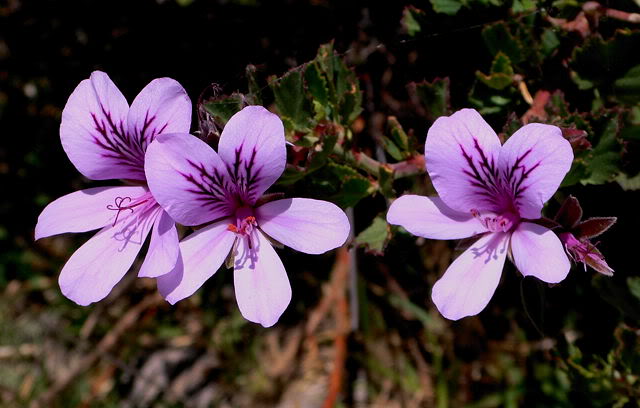
Cape Town
Description
Roughly hairy tall shrub to 2 m with kidney shaped ormore or less round, toothed leaves ±7 cm in diameter; bears clusters of up to 13 pinkish-purple flowers ±40 mm in diameter. Flowers can be variously coloured, from mauve through pink to white.
Distribution
South African endemic; Western Cape.
Habitat
Prefers sandy or granite slopes along the Cape coastal region.
Order Geraniales. Family: Geraniaceae

Cape Town
Description
Roughly hairy tall shrub to 2 m with kidney shaped ormore or less round, toothed leaves ±7 cm in diameter; bears clusters of up to 13 pinkish-purple flowers ±40 mm in diameter. Flowers can be variously coloured, from mauve through pink to white.
Distribution
South African endemic; Western Cape.
Habitat
Prefers sandy or granite slopes along the Cape coastal region.
Dewi
What is the good of having a nice house without a decent planet to put it on? (H D Thoreau)
What is the good of having a nice house without a decent planet to put it on? (H D Thoreau)
Re: Africa Wild Flower Book - Order Geraniales
Crane's Bill Monsonia angustifolia (Teebossie)
Order Geraniales. Family: Geraniaceae
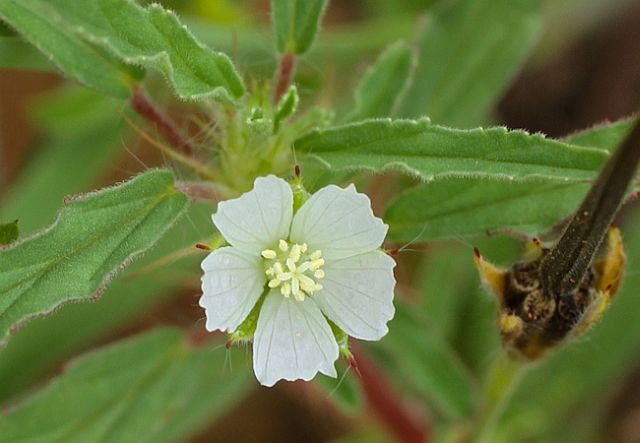 © Super Mongoose
© Super Mongoose
Vaalkop Dam Nature Reserve, North West Province, South Africa
Description
Monsonia angustifolia is an annual herb with wavy leaves that grows up to 0.5 m, although usually shorter. Stems are slightly woody at the base, pubescent and covered with very short gland-tipped hairs among the longer stems. Leaves are narrowly oblong or elliptic, up to c. 3.5 × 1 cm. Margins are irregularly toothed with cuneate bases. Flowers are mauve to blue, or white to yellowish. Fruit are held erect, 50–90 mm long.
Distribution
Throughout South Africa and tropical Africa. Teebossie is widely distributed in the southern African region where it is found in South Africa (Eastern Cape, Free State, Gauteng, KwaZulu-Natal, Limpopo, Mpumalanga, North West) Lesotho, Swaziland, Namibia and Mozambique.
Habitat
Found in open grasslands and often along roadsides or on rocky areas. It occurs on granite and in sandy soils.
Order Geraniales. Family: Geraniaceae
 © Super Mongoose
© Super MongooseVaalkop Dam Nature Reserve, North West Province, South Africa
Description
Monsonia angustifolia is an annual herb with wavy leaves that grows up to 0.5 m, although usually shorter. Stems are slightly woody at the base, pubescent and covered with very short gland-tipped hairs among the longer stems. Leaves are narrowly oblong or elliptic, up to c. 3.5 × 1 cm. Margins are irregularly toothed with cuneate bases. Flowers are mauve to blue, or white to yellowish. Fruit are held erect, 50–90 mm long.
Distribution
Throughout South Africa and tropical Africa. Teebossie is widely distributed in the southern African region where it is found in South Africa (Eastern Cape, Free State, Gauteng, KwaZulu-Natal, Limpopo, Mpumalanga, North West) Lesotho, Swaziland, Namibia and Mozambique.
Habitat
Found in open grasslands and often along roadsides or on rocky areas. It occurs on granite and in sandy soils.
- nan
- Posts: 26430
- Joined: Thu May 31, 2012 9:41 pm
- Country: Switzerland
- Location: Central Europe
- Contact:
Re: Africa Wild Flower Book - Order Geraniales
Bushman's Candle Sarcocaulon crassicaule Geelboesmanskers
Order Geraniales. Family: Geraniaceae
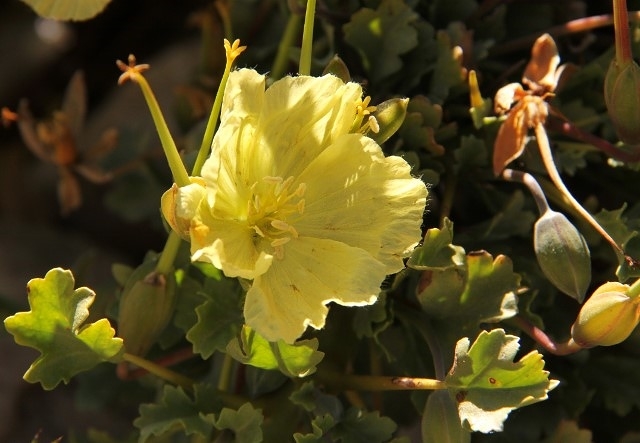
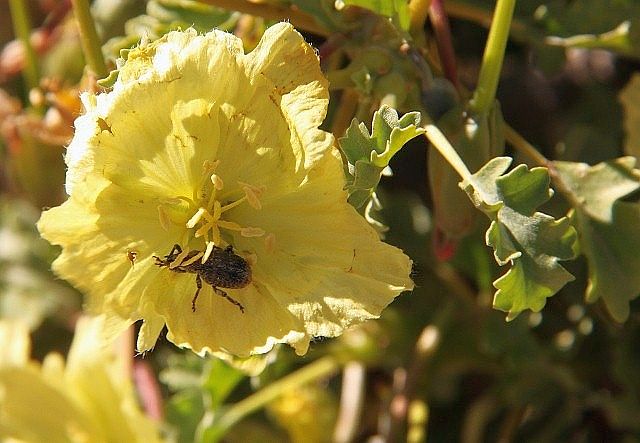
Namaqualand 8.10.2012
Description
Fleshy, rigid, spiny, perennial shrublet, up to 50 cm high; branches grey or grevish yellow. usually more than 10 mm wide; leaves unsegmented with long and short petioles, leaf blade narrowly to broadly obovate, 6-25 × 4-16 mm, margin crenate, slightly hairy (puberulous); spines straight or slightly curved, thick, 1-4 blunt stalks in axils of spines; petals sulphur to pale yellow.
Distribution
Namibia, Northern and Western Cape Provinces of South Africa.
Habitat
Semi-desert areas, usually in rocky places.
Links: The genus Sarcocaulon
Order Geraniales. Family: Geraniaceae


Namaqualand 8.10.2012
Description
Fleshy, rigid, spiny, perennial shrublet, up to 50 cm high; branches grey or grevish yellow. usually more than 10 mm wide; leaves unsegmented with long and short petioles, leaf blade narrowly to broadly obovate, 6-25 × 4-16 mm, margin crenate, slightly hairy (puberulous); spines straight or slightly curved, thick, 1-4 blunt stalks in axils of spines; petals sulphur to pale yellow.
Distribution
Namibia, Northern and Western Cape Provinces of South Africa.
Habitat
Semi-desert areas, usually in rocky places.
Links: The genus Sarcocaulon
Kgalagadi lover… for ever
https://safrounet.piwigo.com/
https://safrounet.piwigo.com/
- nan
- Posts: 26430
- Joined: Thu May 31, 2012 9:41 pm
- Country: Switzerland
- Location: Central Europe
- Contact:
Re: Africa Wild Flower Book - Order Geraniales
Crane's Bill Pelargonium pulchellum
Family: Geraniaceae
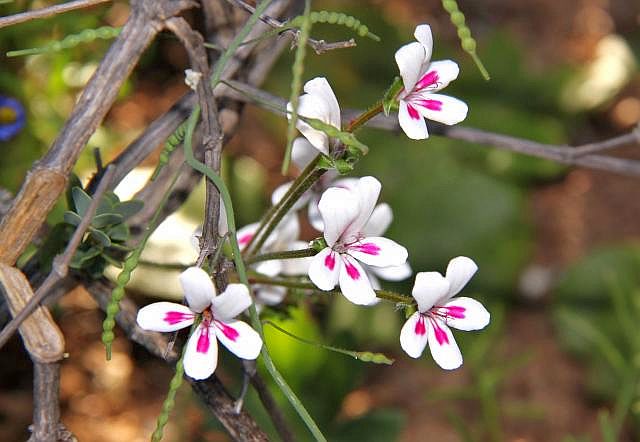
8.10.2012 - Namaqualand
Description
Erect to procumbent, deciduous shrub, up to 50 cm high. Stems relatively short, young stems succulent, becoming woody with age, covered with remains of petioles and stipules. Leaves on short, hairy petioles, oblong, silky, inciso-pinnatifid, the lobes oblong, acute; stipules broadly ear-shaped, acute, adnate, rigid, veiny, silky; scapes branched, pilose, with many-flowered umbels and lanceolate, silky bracts; outer flowers pedicellate, inner sub-sessile, the calyx-tube many times longer than the lanceolate, hairy sepals. Stem scarcely branched, sometimes obsolete. Stipules remarkably broad and stiff. The petals are white, each or three of them with a large, deep red spot.
Distribution
South African endemic, Northern Cape.
Family: Geraniaceae

8.10.2012 - Namaqualand
Description
Erect to procumbent, deciduous shrub, up to 50 cm high. Stems relatively short, young stems succulent, becoming woody with age, covered with remains of petioles and stipules. Leaves on short, hairy petioles, oblong, silky, inciso-pinnatifid, the lobes oblong, acute; stipules broadly ear-shaped, acute, adnate, rigid, veiny, silky; scapes branched, pilose, with many-flowered umbels and lanceolate, silky bracts; outer flowers pedicellate, inner sub-sessile, the calyx-tube many times longer than the lanceolate, hairy sepals. Stem scarcely branched, sometimes obsolete. Stipules remarkably broad and stiff. The petals are white, each or three of them with a large, deep red spot.
Distribution
South African endemic, Northern Cape.
Kgalagadi lover… for ever
https://safrounet.piwigo.com/
https://safrounet.piwigo.com/
- nan
- Posts: 26430
- Joined: Thu May 31, 2012 9:41 pm
- Country: Switzerland
- Location: Central Europe
- Contact:
Re: Africa Wild Flower Book - Order Geraniales
Namaqualand Beauty, Namaqua Stork's Bill Pelargonium incrassatum (T'Neitjie)
Order: Geraniales. Family: Geraniaceae

Namaqualand 8.10.2012
Description
Tuberous perennial herb, up to 30 cm high with a turnip-shaped tuber.
Leaves in a basal rosette, ovate to narrowly ovate in outline, deeply lobed into scalloped segments, with silvery hairs. The flower colour varies from pinkish magenta to cerise. The flower tube may be as long as 4 cm. Flowers are seen at the end of winter and the start of spring. Flowers in an umbel at the end of a long, erect, unbranched stalk; five petals, upper 2 much larger than the rest.
Distribution
Native to the northwestern Cape.
Habitat
In karroid vegetation, found in elevated mountainous areas and their foothills, usually among granitic rocks, sometimes in areas with very little rainfall and sometimes in areas with more.
Order: Geraniales. Family: Geraniaceae

Namaqualand 8.10.2012
Description
Tuberous perennial herb, up to 30 cm high with a turnip-shaped tuber.
Leaves in a basal rosette, ovate to narrowly ovate in outline, deeply lobed into scalloped segments, with silvery hairs. The flower colour varies from pinkish magenta to cerise. The flower tube may be as long as 4 cm. Flowers are seen at the end of winter and the start of spring. Flowers in an umbel at the end of a long, erect, unbranched stalk; five petals, upper 2 much larger than the rest.
Distribution
Native to the northwestern Cape.
Habitat
In karroid vegetation, found in elevated mountainous areas and their foothills, usually among granitic rocks, sometimes in areas with very little rainfall and sometimes in areas with more.
Kgalagadi lover… for ever
https://safrounet.piwigo.com/
https://safrounet.piwigo.com/
Re: Africa Wild Flower Book - Order Geraniales
Variable stork's-bill Pelargonium luridum (Wildemalva)
Order: Geraniales. Family: Geraniaceae
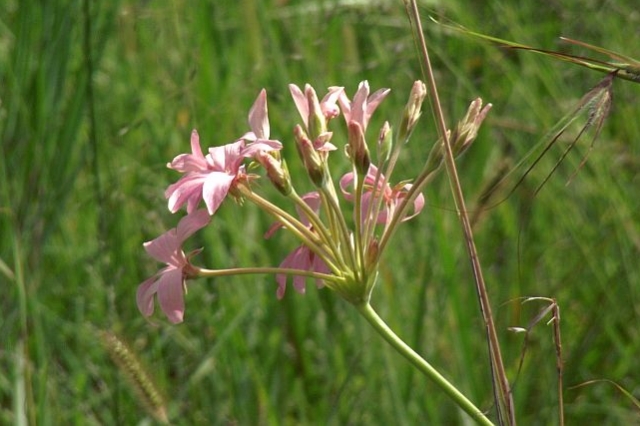 © mposthumus
© mposthumus
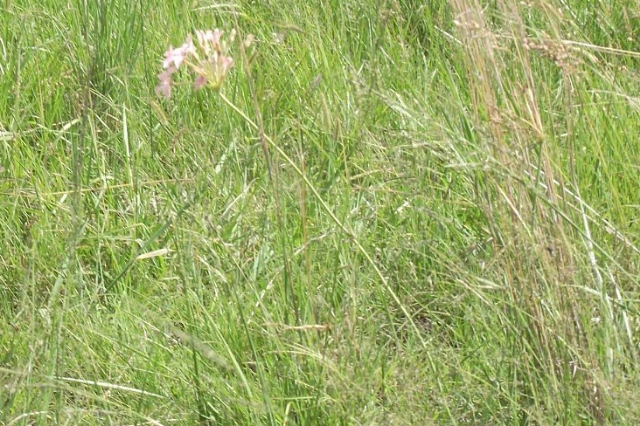 © mposthumus
© mposthumus
Rietvlei Nature Reserve, Gauteng, South Africa
Description
Rootstock perennial; leaves in condensed basal rosette; inflorescence tall with large number of flowers in terminal umbel. Leaves on same plant vary greatly in size and shape, lowest usually having shorter stalks and less divided blades than those higher up. New leaves almost round, or slightly lobed, only becoming more dissected into lobes later. Flowers vary considerably in number and size, irrespective of type of leaf; degree and type of hairiness also vary considerably from plant to plant. Flowers usually white or tinged with pink.
Distribution
DRC, Tanzania, Angola, Zambia, Malawi, Zimbabwe, Mozambique and South Africa (Eastern Cape, Free State, Gauteng, KwaZulu-Natal, Mpumalanga, North West)
Habitat
Open areas and grassland, sometimes in burnt ground.
Order: Geraniales. Family: Geraniaceae
 © mposthumus
© mposthumus © mposthumus
© mposthumusRietvlei Nature Reserve, Gauteng, South Africa
Description
Rootstock perennial; leaves in condensed basal rosette; inflorescence tall with large number of flowers in terminal umbel. Leaves on same plant vary greatly in size and shape, lowest usually having shorter stalks and less divided blades than those higher up. New leaves almost round, or slightly lobed, only becoming more dissected into lobes later. Flowers vary considerably in number and size, irrespective of type of leaf; degree and type of hairiness also vary considerably from plant to plant. Flowers usually white or tinged with pink.
Distribution
DRC, Tanzania, Angola, Zambia, Malawi, Zimbabwe, Mozambique and South Africa (Eastern Cape, Free State, Gauteng, KwaZulu-Natal, Mpumalanga, North West)
Habitat
Open areas and grassland, sometimes in burnt ground.
Re: Africa Wild Flower Book - Order Geraniales
Rose-scented Pelargonium Pelargonium capitatum (Kusmalva)
Order: Geraniales. Family: Geraniaceae
 © Tina
© Tina
West Coast National Park
Description
Pelargonium capitatum is a shrubby or bushy, low-growing sprawling plant. It grows to a height of 50 cm and about 1.5 m wide. The sprawling or erect stems of the plant are soft-wooded and coated in green hairs. Individual side branches can grow to a length of 0.6 m. The stems and leaves are sweetly scented when bruised, and are covered with long, soft hairs of variable density. Leaves are rounded, lobed and crisped, 5 cm in diameter. I bears clusters of up to 20 flowers. The flowers are purple or pink, 15-25 mm in diameter, the floral tube is 3-8 mm long . It flowers from September to October.
Distribution
The rose-scented Pelargonium occurs from Lamberts Bay, all along the coast, through the Eastern Cape to KwaZulu-Natal.
Habitat
Its grows well on sand dunes, flats or low hillsides near the coast. Pelargonium capitatum is commonly found growing in disturbed areas.
Order: Geraniales. Family: Geraniaceae
 © Tina
© TinaWest Coast National Park
Description
Pelargonium capitatum is a shrubby or bushy, low-growing sprawling plant. It grows to a height of 50 cm and about 1.5 m wide. The sprawling or erect stems of the plant are soft-wooded and coated in green hairs. Individual side branches can grow to a length of 0.6 m. The stems and leaves are sweetly scented when bruised, and are covered with long, soft hairs of variable density. Leaves are rounded, lobed and crisped, 5 cm in diameter. I bears clusters of up to 20 flowers. The flowers are purple or pink, 15-25 mm in diameter, the floral tube is 3-8 mm long . It flowers from September to October.
Distribution
The rose-scented Pelargonium occurs from Lamberts Bay, all along the coast, through the Eastern Cape to KwaZulu-Natal.
Habitat
Its grows well on sand dunes, flats or low hillsides near the coast. Pelargonium capitatum is commonly found growing in disturbed areas.
Re: Africa Wild Flower Book - Order Geraniales
Celandine-leaved Pelargonium Pelargonium fulgidum (Rooimalva)
Order: Geraniales. Family: Geraniaceae
 © nan
© nan
Lamberts Bay
Description
Succulent-stemmed perennial shrublet with a scrambling habit.It is 0.4-1.0 m high. The stems become woody with age, and are covered with persistent membranous stipules. It hasonce-divided, densely silvery-silky leaves 10-17 cm in diameter, oblong to heart-shaped, with serrated margins and are covered with tiny, silvery hairs, making them silky. It bears clusters of 4-9 carmine or scarlet flowers 15-20 mm in diameter; the floral tube is 20-40 mm long.Flowering occurs from winter to early summer (June to November).
Distribution
Namaqualand and the West Coast, confined mostly to the western coastal districts. It occurs from the Orange River through the Namaqualand Klipkoppe and the Knersvlakte of Namaqualand, to Yzerfontein in the Western Cape.
Habitat
Rocky slopes, often coastal granite or sand hills.
Order: Geraniales. Family: Geraniaceae
 © nan
© nanLamberts Bay
Description
Succulent-stemmed perennial shrublet with a scrambling habit.It is 0.4-1.0 m high. The stems become woody with age, and are covered with persistent membranous stipules. It hasonce-divided, densely silvery-silky leaves 10-17 cm in diameter, oblong to heart-shaped, with serrated margins and are covered with tiny, silvery hairs, making them silky. It bears clusters of 4-9 carmine or scarlet flowers 15-20 mm in diameter; the floral tube is 20-40 mm long.Flowering occurs from winter to early summer (June to November).
Distribution
Namaqualand and the West Coast, confined mostly to the western coastal districts. It occurs from the Orange River through the Namaqualand Klipkoppe and the Knersvlakte of Namaqualand, to Yzerfontein in the Western Cape.
Habitat
Rocky slopes, often coastal granite or sand hills.
Re: Africa Wild Flower Book - Order Geraniales
Giant Honey Flower Melianthus major (Kruidjie-roer-my-nie)
Order: Geraniales. Family: Melianthaceae
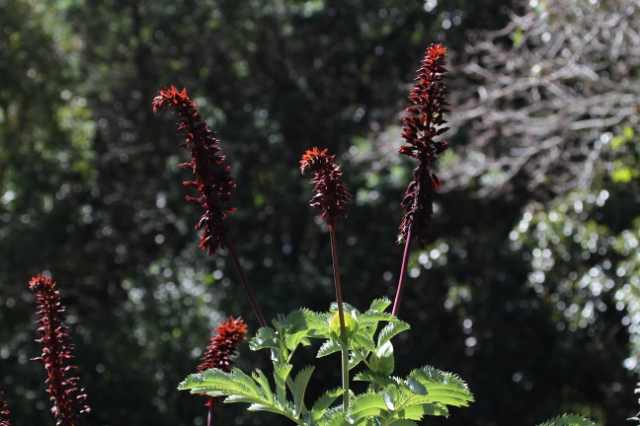 © Tina
© Tina
Kirstenbosch
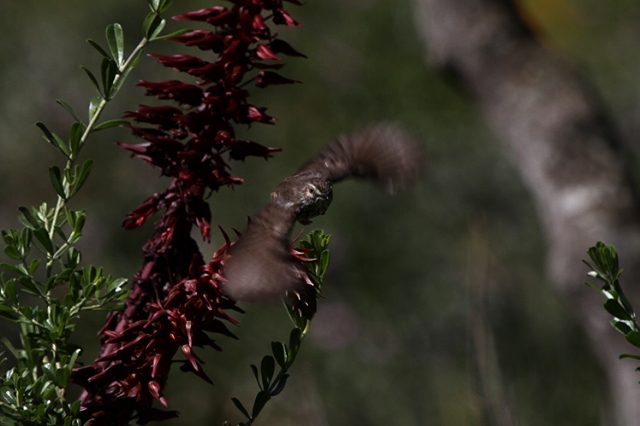 © Tina
© Tina
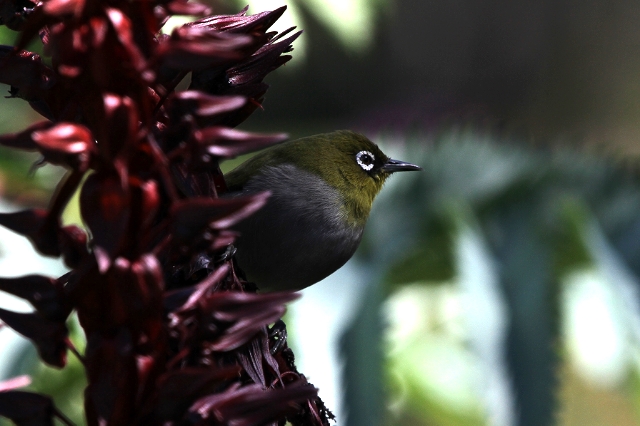 © Tina
© Tina
Cape White-eye
Description
Melianthus major grows to 2–3 m tall by 1–3 m wide. It has large deeply divided blue-green leaves 30–50 cm long, which have a distinctive odour. The leaf divides into narrow, opposite leaflet-like lobes or segments that have large teeth along their margins. These strip-like leaf lobes droop just slightly, inclined at angles that produce striking effects. The leaf surface is hairless, but covered in a grey bloom.
The dark red to maroon flowers presented on strong peduncles are densely spread along the long, erect or curved racemes. The reddish petals are shorter than the maroon sepals in this species. The flowers appear at the end of winter and early in spring, contrasting elegantly against the colour of the foliage below.
The pale green fruits are hairless pods.
All parts of the plants are poisonous.
Distribution
Along the coastal strip of the Northern and Western Cape and western parts of the Eastern Cape.
Habitat
Mostly along streams and roadside ditches.
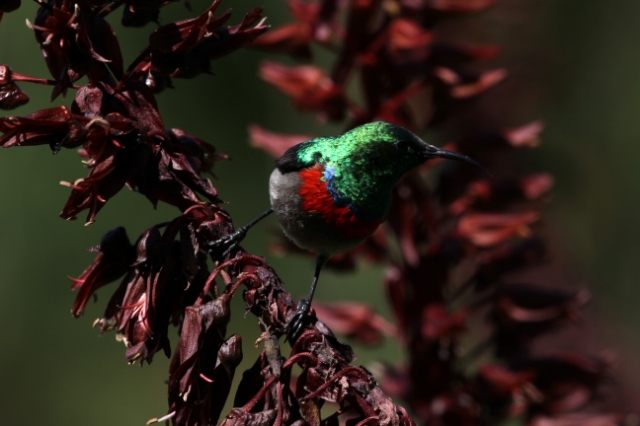 © Tina
© Tina
Male Southern Double-collared Sunbird, Kirstenbosch
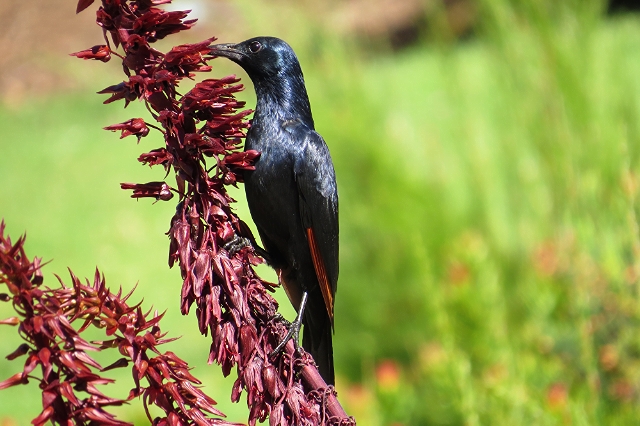 © Tina
© Tina
Red-winged Starling, Kirstenbosch
 © Michele Nel
© Michele Nel
Cape White-eye, Kirstenbosch
Order: Geraniales. Family: Melianthaceae
 © Tina
© TinaKirstenbosch
 © Tina
© Tina © Tina
© TinaCape White-eye
Description
Melianthus major grows to 2–3 m tall by 1–3 m wide. It has large deeply divided blue-green leaves 30–50 cm long, which have a distinctive odour. The leaf divides into narrow, opposite leaflet-like lobes or segments that have large teeth along their margins. These strip-like leaf lobes droop just slightly, inclined at angles that produce striking effects. The leaf surface is hairless, but covered in a grey bloom.
The dark red to maroon flowers presented on strong peduncles are densely spread along the long, erect or curved racemes. The reddish petals are shorter than the maroon sepals in this species. The flowers appear at the end of winter and early in spring, contrasting elegantly against the colour of the foliage below.
The pale green fruits are hairless pods.
All parts of the plants are poisonous.
Distribution
Along the coastal strip of the Northern and Western Cape and western parts of the Eastern Cape.
Habitat
Mostly along streams and roadside ditches.
 © Tina
© TinaMale Southern Double-collared Sunbird, Kirstenbosch
 © Tina
© TinaRed-winged Starling, Kirstenbosch
 © Michele Nel
© Michele NelCape White-eye, Kirstenbosch


